The National Feral Pig Action Plan
Kangaroo Island Feral Pig Eradication Program, South Australia
This program is located on Kangaroo Island (KI), South Australia with activities primarily focussed on the western half of the island.
This program aims to eradicate feral pigs from KI by July 2023.
Innovative approaches to feral pig control, population monitoring, program planning and implementation, community engagement and practice change are being successfully applied to achieve the objective of this program.
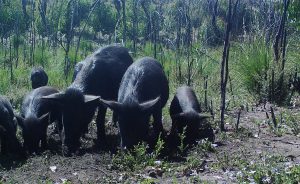
What's been achieved
- As of April 1, 2022, a total of 813 pigs have been culled using a combination of thermal assisted aerial culling (TAAC), baiting (using HOGGONE®), trapping and ground shooting.
- It is estimated there are less than 100 feral pigs remaining on KI.
Background
In 2017, the cost of feral pig impacts on KI were estimated at around $1 million annually, with costs borne mostly by primary producers.
On the island, feral pigs cause severe economic impacts to pastures, grain and potato crops, and damage fences and dams. They also a significantly threaten the island’s unique biodiversity, as they destroy native habitats, prey on native fauna, cause erosion, and spread weeds and diseases including Phytophthora cinnamomi.
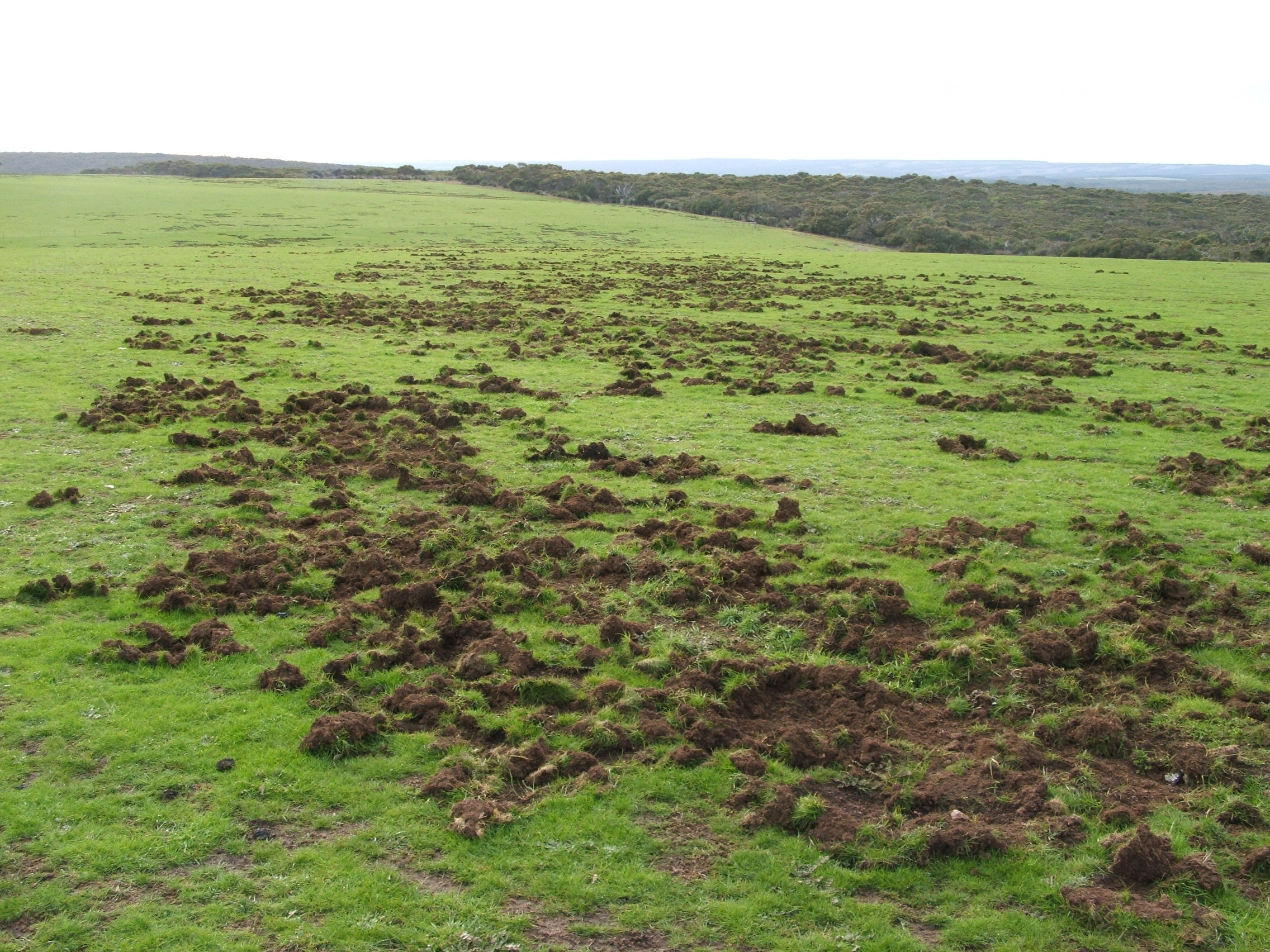
In January 2020, bushfires devastated the western half of KI. Nearly half of the island was burnt, including most of the preferred habitat for the island’s estimated 5,000 feral pigs. Most feral pigs were killed in the bushfires, and those remaining were aggregated in small unburnt areas, with limited food available.
This presented a unique opportunity to eradicate feral pigs from KI.
A phased approach is being used to eradicate feral pigs from KI:
- Knockdown – reduce target population by 80-99% using tools that can be effectively and broadly applied on a landscape scale.
- Mop up – apply a range of control tools in integrated ways to ensure destruction of remaining feral pigs missed by the initial knockdown phase.
- Proof of freedom – verification of eradication (to the agreed level of certainty) complete removal of feral pigs from KI.
In October 2020, the feral pig-occupied area was divided into five groundwork zones (Figure 1). These zones were designed to utilise defined natural geographic or physical barriers (e.g., vermin proof fencing, land use, water catchments and vegetation types) to reduce the likelihood of feral pig reinvasion following knockdown.
These five groundwork zones have been engaged in steps, with mop-up efforts undertaken within a specific zone before proceeding to the next zone.
To ‘hold the line’ between cleared and infested zones, knockdown work has occurred beyond the current work zone to reduce pressure on zone boundaries. Sites where monitoring tools are placed are determined by operational staff during the mop-up phase within each zone.
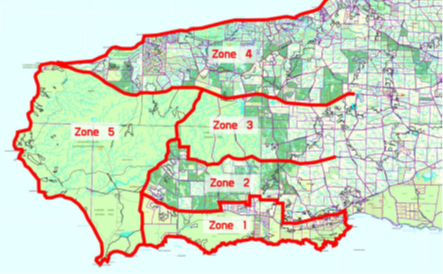
Figure 1: Five groundwork zones established on the western half of Kangaroo Island
Surveys in February 2021 indicated that feral pigs had recolonised watercourses in remote areas of western KI, which are not accessible for trapping and baiting.
Based on thermal surveys of 13.5 km2 along permanent rivers in the western half of the island in February 2021 (which were estimated to see 90 per cent of the pigs in the survey area), the estimated density of pigs was 3.3 pigs per km2. The density of pigs in this habitat is estimated to decrease by 20 per cent over winter, to 2.6 pigs per km2, when additional surface water allows pigs to disperse to other habitats.
In March 2021, the Flinders University Global Ecology group was engaged to model eradication of possible feral pig population size on KI based on different levels of investment in TAAC activities. This modelling was informed by data from a trial TAAC in March 2021. The models were also used to predict associated probabilities of eradication.
The scenarios were:
- No further culling of pigs on KI as of 1 March 2021
- Eradication would not be achieved.
- Assumed that remaining 450 pigs would take 20 years to recover to population of 6,000 pigs in the western half of the island.
- Thermal assisted aerial culling over 21,000 hectares of high-quality pig habitat annually for three years supported by on-ground baiting and trapping activities
- 30 hours of TAAC in summers of 2021, 2022 and 2023 targeting pigs along permanent water courses.
- A 13 per cent probability of eradication by January 2024 was predicted.
- Probability of eradication was predicted to be low due to only 15% of the total area used by pigs covered by thermal assisted aerial surveys.
- Thermal assisted aerial culling over 145,000 hectares (total pig infected area) annually for three years supported by on-ground control activities
- 250 hours of TAAC in winters of 2021, 2022 and 2023 across 145,000 of pig infested area.
- Assumed that 90% of the population would be removed by TAAC.
- Probability of eradication was 100 per cent by January 2023.
- This modelling was based on an estimated population of 450 feral pigs remaining after the March 2021 trial cull.
- Modelling showed that a minimum $1.89 million additional investment was required to achieve eradication by 2023.
Using this modelling (Figure 2), project staff were able to secure an additional $1.8 million investment in TAAC, on top of the existing project budget.
The project is currently on track to achieve eradication by June 2023.
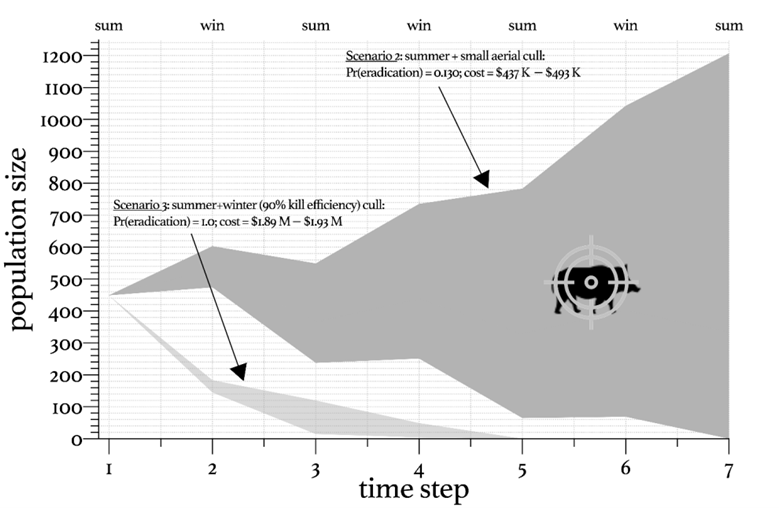
Figure 2: The Flinders University modelling showing the predicted feral pig populations under each of the different funding scenarios.
Stakeholders involved
The project is overseen by the KI Feral Pig Eradication Steering Committee. The Committee’s membership is comprised of representatives from:
- Primary Industries and Regions South Australia (PIRSA)
- SA Department for Environment and Water (DEW), National Parks and Wildlife Service (NPWS)
- KI Council
- KI Plantation Timbers
- Agriculture KI
- Livestock SA
- Australian Pork Limited
- The Royal Society for the Prevention of Cruelty to Animals
- KI Land for Wildlife
Extensive collaboration, engagement and consultation with many stakeholders and project partner organisations on KI has been required to achieve delivery of this program.
A project of this scale, across multiple land use types and land tenures, could only be achieved with significant community engagement.
Project partners and stakeholders include
- Agriculture KI
- Livestock SA
- KI National Parks and Wildlife Service
- KI Landscape Board
- Kiland Ltd (Formerly KI Plantation Timbers)
- BirdLife Australia
- RSPCA
- KI Wildlife Network
- Australian Wildlife Conservancy
- Eco-Action KI
- Hanson Bay Wildlife Sanctuary
- Friends of Parks KI Western Districts
- KI Land for Wildlife
- FaBS Team (Family and Business Support Program)
- Hundreds of private landholders and land managers
Activities being conducted
Combinations of Thermal Assisted Aerial Culling (TAAC), baiting (HOGGONE®), trapping and ground shooting
The program is using TAAC as a key knockdown tool. This tool can be efficiently used on a landscape scale, and is effective in areas with dense vegetation. Thermal assisted aerial culling uses military-grade thermal imaging to scan large areas to detect and cull pigs, so feral pigs can be detected via their heat signature even in dense vegetation. It is more expensive than conventional aerial culling, but improves on the effectiveness of the technique.
In a March 2021 TAAC trial, costing $100,000 jointly funded by the Department of Environment and Water (DEW) and Primary Industries and Regions South Australia (PIRSA), 126 pigs were culled over 36 hours of flight time. Importantly, 99% of the pigs were detected using thermal imaging, compared with only 1% detected by the naked eye.
During 2021, TAAC has been the primary knockdown tool.
Due to the unparalleled ability of the thermal camera to scan large areas for feral pigs, TAAC will also be the primary monitoring and mop-up tool during 2022 and 2023.
The information collected during the TAAC trial was used to establish five TAAC operational areas, that differ from those established for ground operations (Figure 3).
The TAAC operations commenced in Operation Area 1 (OP1) to finish in OP5. Each operational area is being covered by modified adaptable transects that place emphasis on preferred pig habitat, vegetation types, water sources and terrain.
This approach reduces the potential for feral pigs to move behind the culling area.
The speed and field of view of aerial operations is also being used to reduce the risk of pigs moving behind the Operation Area.
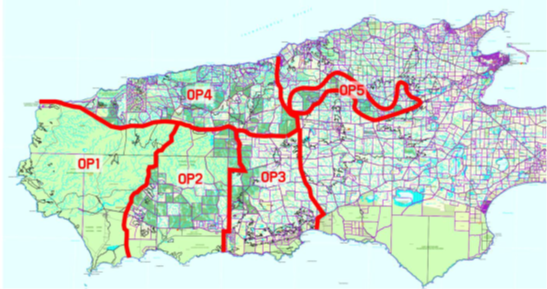
Figure 3: Five Thermal Assisted Aerial Culling zones established on the western half of Kangaroo Island
The first of the high-intensity culls took place in Winter 2021.
Over 5 weeks, a total of 243 feral pigs were culled during 215 hours of flight time. The cull was conducted across 188,000 ha of transects over mixed private properties and National/Conservation parks (Figure 4). The land managers provided written permission for their property to be included in the TAAC operation prior to this activity.
To our knowledge, this is the largest scale aerial cull ever conducted in Australia, and the largest scale TAAC operation in the world to date.

Figure 4: 188,000 ha of transects flown during the Winter 2021 high-intensity Thermal Assisted Aerial Cull. 243 feral pigs were culled in the operation over western Kangaroo Island.
In addition to the summer/autumn hotspot cull in 2022, two more high-intensity culls transecting the entire Western half of KI will be conducted later in 2022 and 2023.
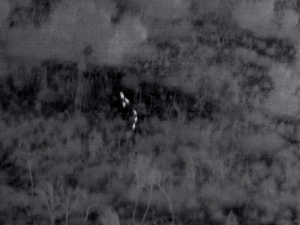
Figure 5: Photo of feral pigs detected by thermal imaging
Baiting, trapping, and ground shooting are the three on-ground control methods being used by operational staff during phase 1 and 2 of the program to support TAAC operations.
A decision support tool is being used to determine which of these control methods are applied in any situation.
Baiting with HOGGONE® (Figure 6) has been the primary ground tool used. It is easy to use, and highly effective.
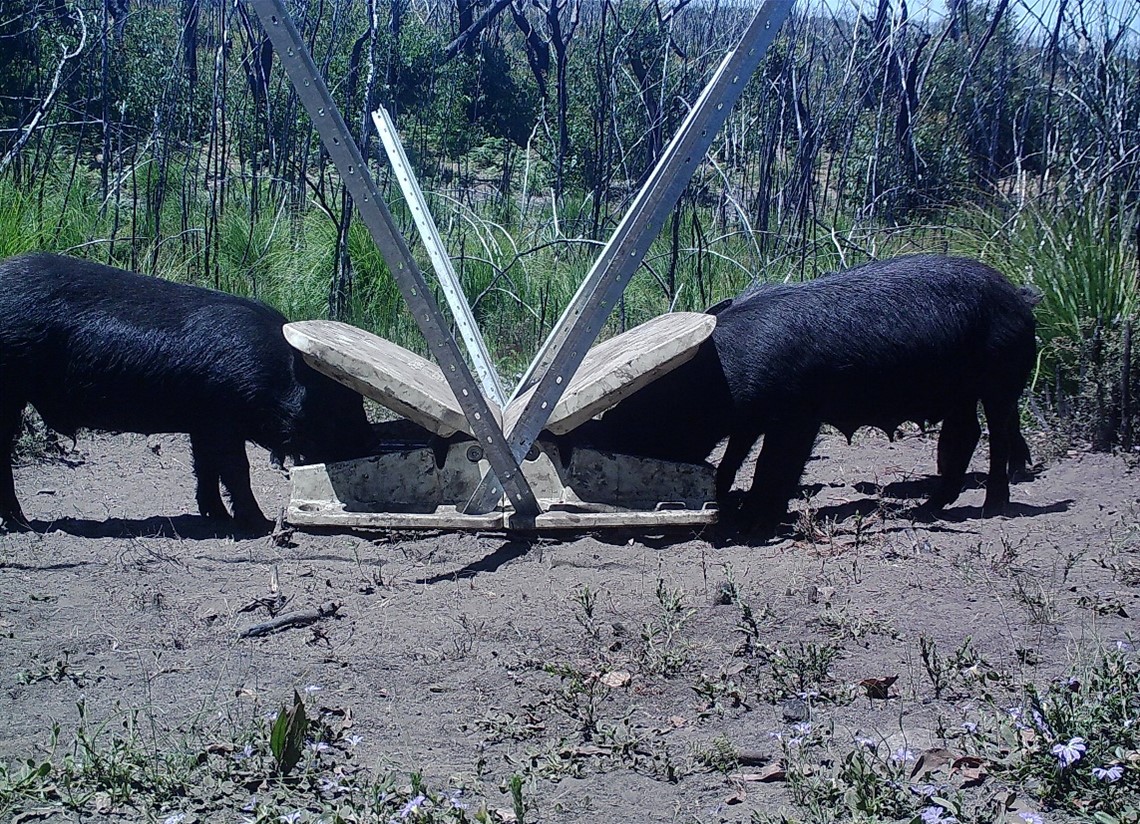
Figure 6: Feral pigs taking HOGGONE® bait from a bait box.
A custom-built “Pig App” has been developed using ArcGIS and ArcField Maps mapping software.
The Pig App can be used offline and on any mobile device.
This centralised mapping system is being used by all operational staff to log pig sightings and other work conducted through the program. The collation of destroyed pig and location data is used to identify locations of feral pig hotspots. The accuracy of feral pig hotspot modelling is being improved through the input of real time data from public reporting, ground operations and TAAC operations.
An extensive monitoring and evaluation program is being undertaken to find and destroy all remaining pigs, and to provide data to demonstrate proof-of-freedom from feral pigs to declare the eradication a success.
Six monitoring tools are being used to monitor for feral pigs:
- Camera surveillance (standard trail cameras) –
- Surveillance cameras are installed at known hotspots and are used on a long-term basis to monitor for feral pig presence, and to verify the absence of pigs in the proof-of-freedom phase of the program.
- Camera trap grids are being installed with decreasing feral pig detections. Camera grids will be in place for one-month periods to provide data for proof-of-freedom from feral pigs.
- 4G connected Artificially Intelligent camera network –
- A 200 strong 4G camera trap network is being deployed across western KI. Each camera will send any images taken to eVorta’s platform, which will automatically scan and report feral pig detections to ground staff in real time.
- This will allow real time monitoring of camera sites with reduced operational resources being required.
- Physical surveillance – by operational staff searching for feral pig signs, scats, or activity.
- Public reporting of feral pig sightings and signs – This data is collected through the ‘’Squeal on a Pig’’ program, using the FeralPigScan app and directly from the community to operational staff.
- Thermal Assisted Aerial Culling/Surveying – to detect and destroy feral pigs as well as undertake visual surveillance to verify proof of freedom over large areas.
- Environmental DNA (eDNA) water sampling – (during the proof of freedom phase only).
- eDNA can provide presence/absence information of feral pigs in a waterway over a long period of time.
- Significant traces of DNA left in waterways by feral pigs when drinking and wallowing can be detected using this method.
- Water samples will be taken from dams, lagoons and waterways and tested.
- A detailed picture of feral pig presence/absence will be established by assessing the relative abundance and detections of eDNA in waterways being monitored over time.
Changes to the List of Declared Animals under the Landscape South Australia Act 2019, and to the state Feral Pig Policy, were made in January 2022 to tighten controls on the keeping of domestic pigs and reduce the risk of domestic pigs becoming feral.
These changes have added a Class to the List of Declared Animals, with the following provisions specific to domestic pigs on KI:
- Permit required to move pigs from the mainland to KI.
- Permit required to keep pigs.
- Pigs cannot be released.
- KI owners of pigs are required to comply with the instructions of Authorised Officers.
- KI owners of pigs are required to control pigs on their properties.
Permits are subject to risk-based conditions relating to identification, fencing and movement.
Funding
Funding of $5.2 million has been obtained from South Australian and Australian Government Disaster Recovery Funding Arrangements, Local Economic Recovery Funds under the National Bushfire Recovery Fund, Livestock SA’s KI Bushfire Recovery Innovation Projects, as well from grants to project partners including the Landcare Led Bushfire Recovery Grants program (awarded to Agriculture KI), the Wildlife and Habitat Community Grants Program (awarded to Livestock SA) and the Revitalising Private Conservation Grants Program (awarded to KI Land for Wildlife).
In the media
AgKI marks 25 years with annual conference The Islander, 14 March 2022
Farmers to benefit as feral pigs to be wiped out on KI The National Tribune, 17 December 2021
Further information
NFPAP feature article
Closing in on eradication- PIRSA, April 2022
Websites
Feral Pig Eradication Program on Kangaroo Island – PIRSA– Official website
Contact
TBC
All figures and photos have been supplied by PIRSA.